Weekly Stock Market Technical Analysis Report - 30th Dec 06
Stock-Markets / Forecasts & Technical Analysis Dec 30, 2006 - 08:48 PM GMTBy: Mike_Burk
The good news is - The Dow Jones Industrial Average (DJIA) and Russell 2000 (R2K) closed at all time highs last week.
Short Term
It is difficult to make a short term technical assessment of the market at this time of the year because seasonal factors dominate.
Intermediate term
New lows begin to increase as the market approaches a significant top.
The chart below covers the past year showing the OTC in magenta and a 10% trend (19 day EMA) of NASDAQ new lows (OTC NL) in blue. OTC NL has been plotted on an inverted Y axis so increasing new lows move the indicator downward (up is good). The indicator is very near the top of the screen suggesting their will be new highs in the index.
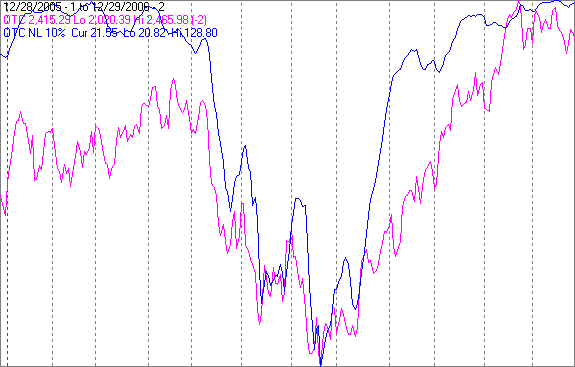
The next chart shows the OTC and a 10% trend of NASDAQ new highs OTC NH in green (the Y axis is conventional). The yearly high for the indicator occurred around February 1st. When the index hit its latest high in late November OTC NH was at a lower level than it was during any of the previous highs in the index.
This indicates that the recent highs in the index have been made with narrowing leadership. Not an ideal condition.
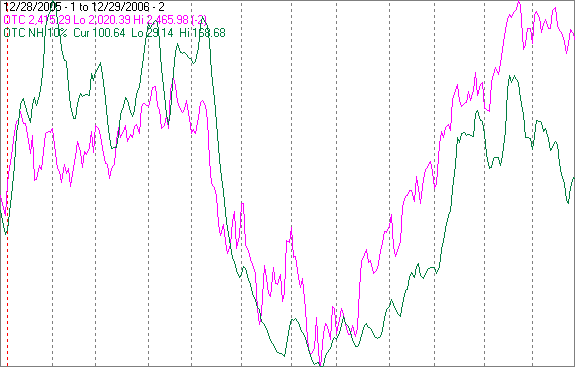
The condition shown above can go on for quite a while. The chart below is similar to the one above except it covers the past 4 years. OTC NH made its high for the period in early 2004 and most of the successive highs in the index have been accompanied by lower highs in OTC NH.
The chart illustrates that we are in the later stages of a bull market.
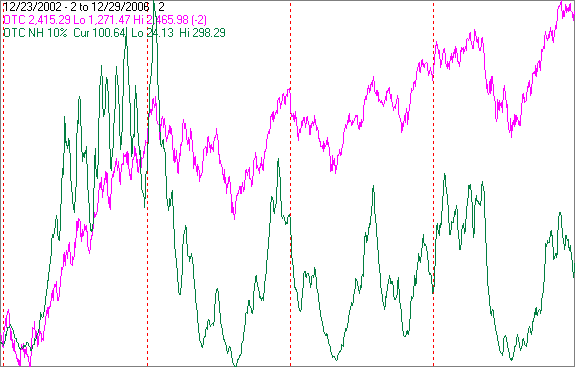
Seasonality
There used to be a rule that required the NYSE to be closed for no more than 3 consecutive days which, I suspect, is the reason markets are open on the day after Thanksgiving. The first exception to the rule, in at least 50 years, occurred after the attacks of 9/11/2001. Now it appears the rule has been abandoned completely. Next week the market will be closed Monday, New Years Day and Tuesday in observance of President Ford's funeral.
Next week will be unique, including just the 1st three days of the 3rd year in the Presidential Cycle.
In the tables below, OTC data covers the period from 1967 - 2003 and SPX data from 1931 - 2003 during the 3rd year of the Presidential Cycle. There are summaries for both the 3rd year of the Presidential Cycle and all years combined beginning with 1964 for the OTC and 1929 for the S&P 500 (SPX).
The OTC has been up about 80% of the time with an average return of over 2%. The SPX has been up over 80% of the time with an average return of nearly 1.5%. This period during the 3rd year of the Presidential Cycle has been stronger than the average for all years.
Report includes the first 3 days of January.
The number following the year represents its position in the presidential cycle.
The number following the daily return represents the day of the week;
1 = Monday, 2 = Tuesday etc.
| OTC Presidential Year 3 | ||||
| Day1 | Day2 | Day3 | Totals | |
| 1967-3 | 0.41% 2 | -0.04% 3 | 0.92% 4 | 1.29% |
| 1971-3 | 0.35% 1 | -0.87% 2 | 0.66% 3 | 0.14% |
| 1975-3 | 1.47% 4 | 0.87% 5 | 0.83% 1 | 3.18% |
| 1979-3 | -0.12% 2 | 1.08% 3 | 1.30% 4 | 2.26% |
| 1983-3 | -0.78% 1 | 0.46% 2 | 0.51% 3 | 0.19% |
| Avg | 0.27% | 0.30% | 0.85% | 1.41% |
| 1987-3 | 1.27% 5 | 2.24% 1 | 1.34% 2 | 4.85% |
| 1991-3 | -0.44% 3 | -1.26% 4 | -0.07% 5 | -1.77% |
| 1995-3 | -1.11% 2 | 0.30% 3 | -0.02% 4 | -0.83% |
| 1999-3 | 0.70% 1 | 1.96% 2 | 3.08% 3 | 5.74% |
| 2003-3 | 3.69% 4 | 0.16% 5 | 2.47% 1 | 6.32% |
| Avg | 0.82% | 0.68% | 1.36% | 2.86% |
| OTC summary for Presidential Year 3 1967 - 2003 | ||||
| Averages | 0.54% | 0.49% | 1.10% | 2.14% |
| % Winners | 60% | 70% | 80% | 80% |
| MDD 1/4/1991 1.77% -- 1/3/1995 1.11% -- 1/5/1971 .87% | ||||
| OTC summary for all years 1964 - 2006 | ||||
| Averages | 0.09% | 0.66% | 0.36% | 1.11% |
| % Winners | 57% | 72% | 65% | 74% |
| MDD 1/2/2001 7.23% -- 1/5/2000 6.14% -- 1/5/2005 3.87% | ||||
| SPX Presidential Year 3 | ||||
| Day1 | Day2 | Day3 | Totals | |
| 1931-3 | 3.32% 5 | 1.45% 6 | -0.93% 1 | 3.84% |
| 1935-3 | 0.11% 3 | 0.21% 4 | -0.21% 5 | 0.11% |
| 1939-3 | -0.98% 2 | 1.15% 3 | -1.28% 4 | -1.12% |
| 1943-3 | 0.72% 6 | 0.81% 1 | -0.20% 2 | 1.33% |
| 1947-3 | -0.65% 4 | 0.39% 5 | 0.26% 6 | 0.00% |
| 1951-3 | 1.76% 2 | -0.39% 3 | 0.87% 4 | 2.25% |
| 1955-3 | 2.14% 1 | -0.90% 2 | -2.47% 3 | -1.23% |
| 1959-3 | 0.42% 5 | 0.40% 1 | -0.13% 2 | 0.69% |
| 1963-3 | -0.65% 3 | 1.64% 4 | 0.64% 5 | 1.64% |
| Avg | 0.60% | 0.23% | -0.16% | 0.67% |
| 1967-3 | 0.06% 2 | 0.21% 3 | 1.30% 4 | 1.58% |
| 1971-3 | -1.09% 1 | 0.71% 2 | 0.60% 3 | 0.23% |
| 1975-3 | 2.44% 4 | 0.68% 5 | 0.51% 1 | 3.63% |
| 1979-3 | 0.65% 2 | 1.11% 3 | 0.80% 4 | 2.55% |
| 1983-3 | -1.64% 1 | 2.18% 2 | 0.43% 3 | 0.97% |
| Avg | 0.08% | 0.98% | 0.73% | 1.79% |
| 1987-3 | 1.77% 5 | 2.33% 1 | 0.23% 2 | 4.33% |
| 1991-3 | -1.14% 3 | -1.39% 4 | -0.28% 5 | -2.82% |
| 1995-3 | -0.03% 2 | 0.35% 3 | -0.08% 4 | 0.23% |
| 1999-3 | -0.09% 1 | 1.36% 2 | 2.21% 3 | 3.48% |
| 2003-3 | 3.32% 4 | -0.05% 5 | 2.25% 1 | 5.52% |
| Avg | 0.76% | 0.52% | 0.87% | 2.15% |
| SPX summary for Presidential Year 3 1931 - 2003 | ||||
| Averages | 0.55% | 0.65% | 0.24% | 1.43% |
| % Winners | 58% | 79% | 58% | 84% |
| MDD 1/5/1955 3.35% -- 1/4/1991 2.79% -- 1/3/1983 1.64% | ||||
| SPX summary for all years 1929 - 2006 | ||||
| Averages | 0.02% | 0.54% | 0.03% | 0.59% |
| % Winners | 46% | 76% | 49% | 68% |
| MDD 1/5/1932 7.02% -- 1/4/2000 4.76% -- 1/5/1955 3.35% | ||||
January
January in the 3rd year of the Presidential Cycle, measured by average return of the OTC, has been the strongest month in the 48 month Presidential Cycle with an average gain of 8.2%. There has been one down January during the 3rd year of the Presidential Cycle, unfortunately it was the most recent one, 2003 when the index lost 4.6%.
The chart below shows the average daily return for January during all years in magenta and January during the 3rd year of the Presidential Cycle in blue.
The number of trading days in January has varied from 20 to 22. The chart has been constructed by averaging the first 11 trading days of the month and the last 10 trading days. The solid vertical line is the dividing point. On shorter months some days in the middle of the month have been counted twice and on longer months some days in the middle have been omitted.
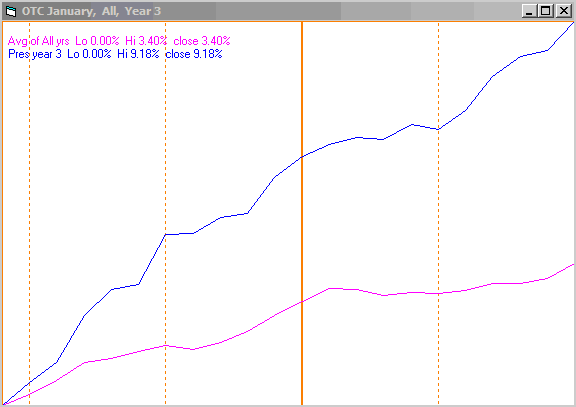
Measured by the SPX, the average return of 3.1% since 1928 in January during the 3rd year of the Presidential Cycle has also been the best month of the 48 month Presidential Cycle. The SPX, like the OTC, was also down in the most recent 3rd year January. Prior to that you have to go back to 1953 when the SPX lost 0.3%.
The chart below is similar to the one above except it uses SPX data beginning in 1928.
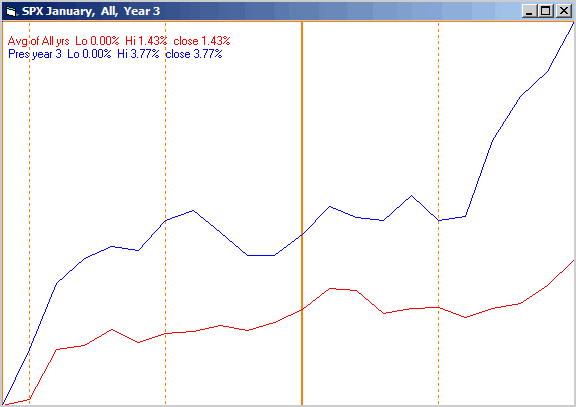
Last year
The first half of 2006 followed a typical Presidential Year 2 pattern while the second half saw an unusually persistent rally that lifted the OTC 18%, the SPX 12%, the Russell 2000 (R2K) 16% and the DJIA 12.5%. The R2K and DJIA closed at their all time highs during the last week of the year.
Conclusion
In the coming week the market has a strong, positive seasonal bias. I expect the major indices to be higher on Friday January 5 than they were on Friday December 29.
By Mike Burke
Mike Burk is an employee and principle of Alpha Investment Management (Alpha) a registered investment advisor. Charts and figures presented herein are believed to be reliable but we cannot attest to their accuracy. The views expressed are provided for information purposes only and should not be construed in any way as investment advice. Furthermore, the opinions expressed may change without notice. To subscribe to this report : http://alphaim.net/signup.html
NOTE - From time to time, The Market Oracle publishes articles from third parties. These articles do not necessarily express the viewpoints of The Market Oracle or its editorial team.© 2005-2022 http://www.MarketOracle.co.uk - The Market Oracle is a FREE Daily Financial Markets Analysis & Forecasting online publication.



